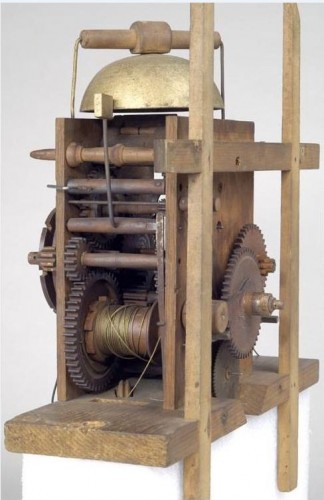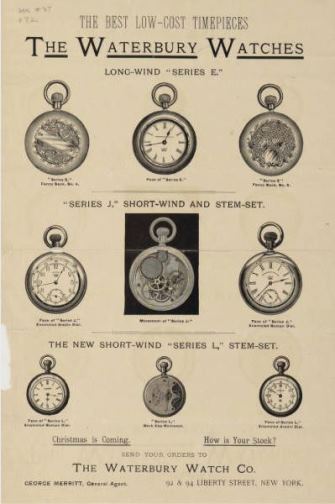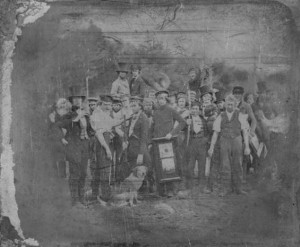The success of the clock- and watch-making industries in Connecticut came about in an era when the state was just beginning to realize its industrial potential. The availability of raw materials, navigable waterways, and the state’s proximity to major metropolitan areas in the Northeast all fostered the growth of several industries in Connecticut, including clock and watch manufacturing. As important as those factors were, the keys to the timepiece industry’s success, however, were the relationships forged between craftsmen and their apprentices that allowed clock and watch production to continually evolve with the changing needs of consumers.
In 1773, clockmaker Thomas Harland arrived in Connecticut from England and set up a shop in Norwich. There he made and repaired timepieces consisting largely of intricate, handmade brass gears. His apprentice, Daniel Burnap, learned the craft well and established his own business in what eventually became South Windsor. Burnap’s great contribution to timepiece manufacturing came in the instruction he provided to a young Eli Terry.
Eli Terry apprenticed himself to Burnap at the age of 14. Seven years later, in 1793, Terry opened his own business and in 1797 received the first clock patent granted by the United States Patent Office. Terry went on to receive 9 more patents over the course of his lifetime.
Terry Becomes Successful Clockmaker
Eli Terry became one of the most renowned clockmakers in history for two primary reasons. The first was that he created a mechanized process for mass producing wooden gears using water-powered saws. This allowed him to produce clocks more efficiently—thus making them affordable to larger numbers of consumers. The second reason was Terry’s development of movements so small that they fit in a case capable of resting on a shelf or mantel. Terry’s “shelf clock” became so popular it helped make Connecticut the most prolific producer of time pieces in the country during the late 18th century.
Terry passed his skills on to a variety of apprentices who proved equally successful at manufacturing timepieces. Wolcott-born Seth Thomas, a carpenter by trade, apprenticed himself to Terry in 1807 to help build the intricate wheels and other parts of Terry’s wooden clock movements. Between 1807 and 1810, Thomas, Terry, and Silas Hoadley worked together to produce approximately 4,000 clocks.

Eight-day weight-powered wood movement, Eli Terry, Plymouth – Connecticut Historical Society
In 1813, Thomas left the business to go out on his own. Three years later, fresh from the training he received in Waterbury, Chauncey Jerome joined forces with Eli Terry. The two men produced Terry’s new shelf clocks with such success that clock manufacturing enterprises began popping up all over Connecticut.
In 1821, Chauncey Jerome started his own business in Bristol. There he and his partners mechanized the production of brass movements. Jerome then opened a case factory in New Haven in 1844 and moved all of his operations there the following year. Financial difficulties eventually forced Jerome’s business to go bankrupt, however, and it merged with the New Haven Clock Company in 1856.
Clockmaking Throughout Connecticut
Other clock companies proved more successful. Bristol witnessed the establishment of the E. N. Welch Manufacturing Company in 1830, the birth of E. C. Brewster & Company in 1835, and eventually E. Ingraham & Company several years later. The industry gained an even stronger foothold in Connecticut with the establishment of the William L. Gilbert Clock Company in Winsted in 1866 and from the New York firm of Terry & Andrews, which moved to Ansonia in 1850 and became the Ansonia Clock Company in 1873.
Eli Terry’s legacy carried on through the establishment of the Seth Thomas Clock Company in 1853. Thomas, who purchased the manufacturing rights to the shelf clock from Terry, produced some of the most popular clocks of the era. After Seth Thomas’s death in 1859, the state of Connecticut incorporated the western part of Plymouth Hollow where he worked as the town of “Thomaston.”
The Beginnings of Timex
While numerous companies benefited from the designs of Terry and his disciples, perhaps none matched the success of the Waterbury Clock Company. Originally a department of the Benedict & Burnham Manufacturing Company, the Waterbury Clock Company incorporated as a unique entity on March 27, 1857. Taking advantage of the popularity of shelf clocks, the Waterbury Clock Company sold its products around the world and by 1896 had salesrooms in New York, Chicago, and Glasgow, Scotland.

Best low-cost timepieces, The Waterbury Watches. – Connecticut Historical Society
One of the company’s best-selling products was its “dollar” watch. Made of movements small enough to fit in casing that could be carried in someone’s pocket, the watch (known as the “Jumbo”) was an inch and a half thick and three inches in diameter. It sold for $1.50 and proved wildly popular with the American public.
In 1922, the Waterbury Clock Company purchased the bankrupt watch-making enterprise of Robert H. Ingersoll & Bro. and began focusing on producing smaller and smaller movements designed to fit on a person’s wrist. In the 1930s they designed one of the most iconic watches in US history after obtaining a license to produce a watch featuring Mickey Mouse on its face. Two decades later, they released an inexpensive and reliable wristwatch they named the “Timex.” The product eventually became such an important part of the company’s business that the company changed its name to Timex in the 1960s.
Today, clock and watch making continues to be an essential part of Connecticut’s identity. While large, multinational corporations replaced the intimate workshops of early craftsmen, the legacy of the industry’s pioneers and the enterprises that emerged in their wake are preserved at institutions like the Timexpo Museum in Waterbury and the American Clock and Watch Museum in Bristol.









